



Article from Clover:
Today the City took delivery of 10 new zero-pollution Nissan LEAF electric cars. These pollution-free electric cars are an investment in a smarter, cleaner and quieter city.
Last year 120,000 plug-in electric vehicles were sold globally and manufacturers estimate that in 2020 up to one third of their global sales will be electric or hybrids as demand grows, prices fall, and consumers move away from using fossil fuels.
While our current fleet of hybrid cars is a step in the right direction, hybrids still need to burn petrol, which creates pollution.
As part of our regular fleet upgrades, we are taking advantage of new technology created by Nissan to clean up Sydney’s air.
The NSW Government’s State of the Environment Report recently said Sydney’s air quality was continuing to exceed national standards on some days of the year.
The Nissan LEAF produces no pollution; in fact, they don’t even have a tailpipe! This means less carbon monoxide, nitrogen dioxide and other noxious gases being pumped into Sydney’s air.
Any pollution created by charging the electric vehicles will be offset by zero-carbon electricity produced by new solar panels being installed on City buildings.
Over the next 18 months 5,500 solar panels will be installed on 30 buildings, creating one of the largest building-mounted solar installations in Australia.
These electric cars are extremely cost-effective. They are 85 per cent cheaper to run than standard petrol cars – in fact they have the lowest running cost of any car on the market. They have a range of 170 km before they need a recharge.
We know that already more than 700,000 cars move about central Sydney each day contributing to pollution, congestion and noise.
To make electric vehicles a more viable options for people, government and industry must work together to install the critical infrastructure drivers need to easily recharge their vehicles.
The City has installed seven electric charging stations at its public parking stations in Kings Cross and Goulburn Street.
Australia’s first public electric-vehicle charging station was installed by Charge Point in Glebe, in 2010. It charges a plug-in Prius operated by GoGet car share, and is used by more than 500 residents and businesses.
The City is helping to reduce the impact our transport has on Sydney and supporting the growth of zero-pollution electric vehicles.
A shift to electric cars powered by low-carbon energy has benefits for everyone – lower running costs, lower pollution and quieter streets.

Article from Sydney Morning Herald:

IT WAS Intel founder Gordon E. Moore who observed in 1965 that there was a doubling in the power of computer chips every two years.
Moore predicted this trend would persist for another 10 years and his prognostications have proven eerily correct. Even extrapolating Moore's Law, as it became known, beyond the realms of semiconductors into digital technology and elsewhere, technology tends to double in power every couple of years.
And as the performance increases, the price drops in sync.
It is to this phenomenon that electricity consumers can pin their hopes in coming years as they grapple with rising power bills. The technology to deliver cheaper energy is here.
The question is: can industry and government deliver?
Already, solar power has hit a ''tipping point',' where it is economic without government subsidies.
This was one of the findings of a recent draft report by engineer Robert Rollinson on the electricity industry on the New South Wales mid-north coast.
The Melbourne Energy Institute's Professor Mike Sandiford says solar PV (photovoltaic) is close to ''grid parity''.
''PV [pricing] has been trending down with a 20-25 per cent cost reduction for every doubling of capacity globally.''
This, however, is no guarantee of relief from surging prices.
The electricity industry needs to get a return on its massive spending over recent years - spending which has been the impetus behind nosebleed power bills.
Thanks to the high fixed costs of the network, even if consumers were to flee the grid in droves for wind and solar power, many would still use it for a portion of their power needs.
Less savvy consumers - read the most needy - will still be stuck on the grid.
For industry, the unpleasant consequence of falling demand and the incursion of solar power is the prospect of large write-downs at a time when the Queensland and NSW governments are keen to privatise their transmission and distribution assets.
There is a little ray of sunshine, though.
Electric cars may take up surplus capacity on the grid in the off-peak hours. You charge them at night.
Like TV sets, digital cameras and DVD players, electric cars have rapidly improved in performance and dropped in price.
A paper from the Australian Energy Markets Commission estimates that electric cars will make up 20 per cent of all new vehicle sales in Australia by the end of this decade and 45 per cent by 2030.
If consumers charge their cars overnight the AEMC says that electricity demand will rise only 4 per cent by 2030.
The cost of charging an electric car during the night is about 1¢ per kilometre versus 10¢ a kilometre to fuel a petrol car.
Ergo, lower costs for consumers and higher demand for the networks at times of when they have most un-utilised capacity and therefore no need to make capital expenditures (or operating expenditures, for that matter).
A win-win.
The incremental off-peak revenue flows to industry (the five-year regulatory periods allow for significant capture; then it's, fingers-crossed that the regulators don't roll the same opportunities for ''gold-plating'', or unnecessary expenditure, into the next period). Off-peak prices are lower, but this is incremental revenue nonetheless, and revenue gained without offsetting capital or operating costs.
Are electric cars at a tipping point, too?
Over the New Year, Nissan unveiled the pricing for its entry level LEAF electric vehicle at $US28,800 ($A27,900) - that's 18 per cent cheaper than the most basic 2012 model and presents a robust challenge to GM's dominant offering, the Volt.
Applying the US federal incentive, the price of the new LEAF is an aggressive $US21,300, or as low as $US18,800 in California once the state rebate has been discounted.
The tumbling Japanese yen will make imported electric cars far cheaper in Australia, too, or at least for as long as the $A remains high.
In Australia though, if high power prices persist, particularly in off-peak, they may act as an impediment to take-up of electric cars.
As an interesting aside, one corollary of the carbon tax is that it will also act as an impediment to take-up as it is a very large share of off-peak costs but not so much for on-peak - and the tax is not levied on its competitor: petrol.
While electric cars may prove a happy if unintended consequence of technology for the electricity networks, industry remains in denial when it comes to solar PV.
Research by Mike Sandiford last year estimated that, thanks to the spectacular take-up of solar panels, there would be in excess of 2 gigawatts of solar PV capacity installed by now, enough to produce about 8 per cent of the average daytime electricity demand.
Rather than being hard to measure, Sandiford says the solar PV signature is ''blindingly obvious'', putting big dents in electricity consumption figures in the places where PV penetration is highest.
''In South Australia, midday to early afternoon demand was down over the financial year 2011-12 by about 8 per cent on the average for the period spanning mid- 2007 through mid-2009. That contrasted with a negligible change in demand outside daylight hours,'' said Sandiford.
If his estimates are even roughly correct, the electricity industry is in for a shock.
Revenues were down 35 per cent, or $3.3 billion, across the National Electricity Market in 2011-12, compared with the $9.6 billion in turnover for the two years prior to mid-2009.
If solar PV deployment proceeds at its present pace, it will take only 18 months to reduce midday demand to current midnight levels.

Article from The Saturday Age:
Move aside, car makers, this US manufacturer is bringing its zero-emission vehicles Down Under, writes GEOFF PARADISE
While car manufacturers around the globe have embraced hybrid technology (petrol-electric or diesel-electric), one relatively unknown truck maker has been quietly building and selling all-electric six to 12-tonne medium-duty trucks in the northern hemisphere for the best part of three years, and it is coming to Australia.
Smith Electric Vehicles, once British-owned and renowned for its electric “milk floats” favoured by milkmen during the past 90 years, is now controlled by an American company following a buyout in 2011. Smith Electric Vehicles US has been beavering away at three factories in North America (Kansas City, Chicago and New York), where it builds trucks in left-hand drive for a wide customer base.
A plant at Newcastle in Britan builds trucks in right-hand drive for domestic and overseas markets.
Smith electric trucks have been embraced by some very environmentally aware, blue-chip companies overseas. TNT, Coca-Cola, DHL, Sainsbury’s, the US Marines and PepsiCo own and operate Smith vehicles in either Britain or the US.
PepsiCo has perhaps the largest fleet of Smith trucks, with 176 units in its Frito-Lay division, and it says its diesel fule savings will amount to 1.8 million litres annually.
Drive can reveal that plans are under way to have these zero-emission, near-noiseless trucks on the Australian market in 2013, according to a senior executive of the importer, Avia Oceania.
Chief operating officer Tony Fairweather has confirmed that a right-hand-drive Smith electric truck, the Newton model, will be on display at the truck industry’s premier event, the Brisbane Truck Show, to be held in May and says Australian compliance is well under way, paving the way for a 2013 launch.
It will stand alongside a Czech-built Avia medium-duty truck that will also be imported and sold in Australia. Smith also offers a sub-4.5-tonne electric vehicle called the Edison, based on the Ford Transit, but it remains to be seen if this will be sold here.
Avia supplies trucks from its Prague-based plant to Smith minus the engine, gearbox, fuel tanks and other components needed to complete a diesel-powered truck.
The vehicles are built in either left- or right-hand-drive and shipped either to Britain or the US, where the electric motor, single-reduction gearbox and sealed 120kW lithium-ion battery pack are installed. The Smith Newton trucks have a range of up to 250 kilometres on a single charge from the 120kWh battery, making them ideal for fixed-route deliveries in the cities, suburbs and regional areas where home base is in the same or nearby postcode.
They have a top speed of 120km/h, which enables them to take advantage of any motorway or link roads, but constant high-speed running will deplete the battery quicker than urban driving. The battery takes eight hours to recharge fully. Specifications for the local models are being finalised and prices will be announced closer to the vehicle’s launch.

Article from The Age:
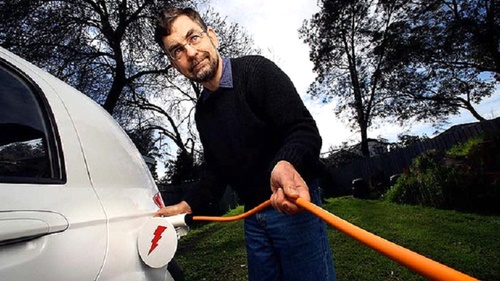
Most Melbourne households could make the leap from petrol-fuelled to electric cars without having to change their daily driving routines.
But the up-front cost of buying an electric car and installing charge points remains a significant barrier for the technology. That's the finding of an update report on Victoria's five-year electric car trial.
The trial gave 120 households and 50 corporate fleets five makes of electric cars for three months to test their experiences, expecting the cars would be adopted in the thousands over coming decades. A mid-trial report found electric vehicles were best suited to drivers who travel up to 50 kilometres a day on average. Most Melbourne motorists do not travel further than 35 kilometres, although a significant minority drive much further.
For those who drive 50 to 80 kilometres, having a charging station at work, as well as at home, or using a plug-in hybrid car was considered a better option. For longer distances, hybrids and traditional cars are the best choice.
Howard Elston, a primary school teacher who drove two cars for the trial, said they needed to be thought of as an urban vehicle used by people who do 95 per cent of their driving around town.
''My trip to work is less than 10 kilometres, so [for] that and to get around the city it was just like any other car. But you just have to be a little conscious of how far it takes to get somewhere and back again,'' Mr Elston said.
Rather than needing charging points around the city, he found his driving needs could be met by charging up once every few days at home using off-peak power.
''If the [purchase] price dropped, I would have one in a flash,'' he said.
Transport Department modelling projects that electric cars could make up 25 per cent of new vehicles sales by 2020. The pace at which they take off will depend on the cost of the cars and charging points - and oil prices.
The report found it cost drivers $7 to $10 a week to charge up with GreenPower electricity.
Households would also need to pay between $2000 and $3000 to install chargers, with renters facing extra challenges.
The modelling finds electrical vehicles could deliver $1.8 billion to $23.4 billion in economic benefits to Victoria by 2040, depending on car costs, oil prices and the availability of public charging points.
Craig Memery, energy policy advocate at the Alternative Technology Association, said the biggest changes were likely to come in two-car households that had a petrol car to fall back on.
Bryce Gaton, of East Brighton, drives his electric-converted 2011 Hyundai Getz six days a week to work, about 50 kilometres round-trip, leaving him about 30 kilometres worth of power.
Overnight on the off-peak he charges his car. He said he uses his ''fossil car'' for longer trips.

Article from Care2:

Students in the Kings Canyon Unified School District in California’s San Joaquin Valley will be going to and from school in the first all-electric school bus by 2014. A few years ago, the Kings Canyon School District decided to take the plunge and spend about $35,000 for an electric school bus as it’s located in an area with poor air quality. Over the long-term, the electric school bus will also save the district money: it costs about $17 to recharge an electric bus’ battery, vs. about $50 to $60 for the 16 gallons of diesel fuel that traditional buses use.
An estimated 480,000 school buses transport 25 million students (more than half the children who attend school in the United States) to school and back home. Using electric school buses instead of diesel-powered ones has obvious benefits to the environment and for school districts’ budgets.
Trans Tech Bus and Motiv Power Systems presented their new all-electric school bus at the recent 2013 National Association for Pupil Transportation (NAPT) Annual Summit in Grand Rapids, Michigan. As Trans Tech President John Phraner explains, “an electric bus can save a school district about 16 gallons of fuel a day, or around $11,000 in fuel savings over a year, not to mention maintenance savings.”
The new bus, the SST-e, can hold up to 32 children or 24 students and one wheelchair. As more buses are developed, the manufacturers plan to make them available to districts with four or five battery packs, which provide 80 or 100 miles of travel.
Electric vehicles would make great school buses for a couple of reasons, the Wall Street Journal noted back in 2011. School buses “cover fairly short distances on their daily runs, rarely leaving city limits on the way to and from school.” They also stick to “set, predictable routes” and thereby cut down on the chance of a bus running out of battery power. As school buses are parked for many hours of the day in bus depots, there is lots of time to recharge their batteries. (Just an hour is needed to recharge the SST-e’s by 50 percent.)
Even more, the frequent stops that school buses make mean that an electric one “can capture some of the energy used in applying the brakes to recharge their batteries, extending their range,” says the the Wall Street Journal. Fleet managers can also be easily kept up-to-date about about the condition of buses, as they are equipped with telemetry systems that provide real-time route data and preventive maintenance reports.
Electric buses could potentially cut down costs in transporting the many students in special education. Such students are entitled to transportation to and from their home and school. Children in Head Start with special health care needs are also supposed to be allowed to take the bus, so a child can attend a special program or school that is far from where they live (my autistic teenager son‘s school is about 40 minutes away from our house but his bus ride is over an hour).
School buses spend a lot of time idling on sidewalks while waiting for students to board; electric ones could certainly help to cut down on carbon emissions, a good portion of which gets released into the air around schools. While the up-front costs for an electric school bus dwarf those of the traditional diesel-powered ones, the benefits are clear.
Why not get the nation’s students off to a good, clean-energy start by building up a fleet of electric school buses?

Article from The Age:


Vmoto is gaining traction in China as a premium product for electric scooter riders. Photo: Bloomberg Scooter manufacturer Vmoto says it is on track to notch up its maiden annual profit in the 2013 calendar year of between $300,000 and $600,000 as it gains traction in the key market of China as a premium product for electric scooter riders. The company said in a statement to the Australian Securities Exchange on Tuesday that it had a profitable month in November, reaping a gain of $201,000, with sales gradually picking up month to month.
In the trading update, Vmoto said the month of December showed turnover for its existing scooter stores and recently opened sites was in line with management expectations.
Vmoto is a scooter maker and distributor and specialises in high-quality ''green'' two-wheel electric-powered vehicles as well as manufacturing a range of Western-designed electric and petrol scooters from its base in Nanjing, China.
Its Vmoto brand is aimed at the value market in Asia while its E-Max label targets Western markets. It distributes its scooters to more than 30 countries.
Vmoto also owns 10 retail outlets in China, having opened four new shops in the past two months.
Vmoto said on Tuesday that it was targeting to churn out 42,000 scooters for the 2013 year. It sold 3197 of its own scooters in China by the end of November.
''The gradual build-up in sales month-on-month are testament to the Vmoto brand becoming increasingly recognised as a premium product for electric scooter riders in China,'' the company said.
The company expects to provide a further earnings update and outlook next month.
Vmoto's shares closed up 1¢ at 31¢ on Tuesday.

Article in The Age from the US:
An increasing number of electric-vehicle driving employees at Silicon Valley companies are finding it hard to access car-charging stations at work, creating incidents of “charge rage” among drivers.
Installation of electric vehicle charging ports at some companies has not kept pace with soaring demand, creating thorny etiquette issues in the workplace, according to the San Jose Mercury News. Peter Graf, chief sustainability officer for German software company SAP, said the company’s 16 charging stations were not nearly enough for the 61 employees who drive electric vehicles.
Mr Graf said cars were being unplugged while charging, creating animosity between employees. A charge can take as little as 30 minutes.
“Cars are getting unplugged while they are actively charging, and that’s a problem,” Mr Graf told the newspaper. “Employees are calling and messaging each other, saying, “I see you’re fully charged, can you please move your car?””
ChargePoint, which operates a large EV-charging network, said companies should provide one charging port for every two of their employees’ electric vehicles.
More and more companies are set to face similar problems as EVs become increasingly popular. Pacific Gas and Electric expects 800,000 electric vehicles to be on state roads by 2020 – there are only 20,000 now – creating a high demand for charging stations. There are about 5000 public and work-place charging stations in California and 20,000 in the US.
“Having two chargers and 20 electric cars is worse than having no chargers and 20 electric cars. If you are going to do this, you have to be willing to continue to scale it,” said Pat Romano, chief executive of ChargePoint.
Some Silicon Valley companies have already taken steps towards alleviating charge rage by introducing a shared calendar for booking time at the charging stations.
“You can only book for a two-hour window. But rule No. 1 is: No one touches anyone else’s car without permission,” said David Gee, the company’s marketing head.

Article from RoyalAuto online - FEBRUARY 2014:
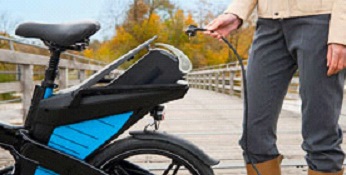
Electric bikes give some power to your pedalling.
Electric bike fever is taking over Victoria and it shows no signs of decelerating. In the past 12 months electric bikes, or e-bikes, have become popular for both the daily commute and the Sunday ride, with people of all ages relishing the motorised assistance. They’re selling like hotcakes as a result.
“In the last 12 months the growth in Australia has been exponential,” Nathan Reizer, co-owner of Melbourne Electric Bikes says.”
Dolomiti bikes partner Giampaolo Zanol agrees. “We opened at the end of 2010 and we have seen sales quadruple,” he says. “The electric bike industry is moving so quickly now and there are so many more brands available and so many more people interested in them.”
In May last year the Australian government adopted the European design rule allowing electric bikes to be powered by 250W and not require pedalling for extra torque.
As part of the European design rule, speeds limits were also increased with e-bikes now able to travel 25km/hr.
“Since the decision we now have an issue trying to import enough stock to meet the demand,” Giampaolo says.
Nathan says: “it was a game-changer” and adds that it will allow Australia to follow the lead of other nations where “the only sector of bikes globally that’s continuing to grow is electric”.
In 2012, 100 million electric bikes were produced internationally. The uptake in Italy and Germany outstrips conventional push bikes and the Netherlands, Austria, America and Canada are not far behind.
Demand is so high that motor vehicle companies including BMW, Audi and Mercedes, and electronic-component companies Panasonic and Samsung have joined the electric bike market.
E-bikes have a small electric motor that the rider can switch on. The price for purchasing an e-bike starts at about $1050 and can edge above $4000. On average a flat battery costs 16 cents to charge and lasts anywhere between 30 and 60km.
The University of Melbourne, Monash University and VicRoads have undertaken numerous research projects that show how e-bikes could encourage more Victorians to take up bike riding as a healthy and sustainable alternative to the car and provide options for older bike riders, or those who may not be as fit as they once were but still want to use pedal power.
Stay tuned for more on electric bikes from RACV.
For now, if you are considering an electric bike, visit Bicycle Network Victoria and check out Ride On Magazine.
Also see Choice or get free advice and independent recommendations from a new not-for-profit service Positive Charge.
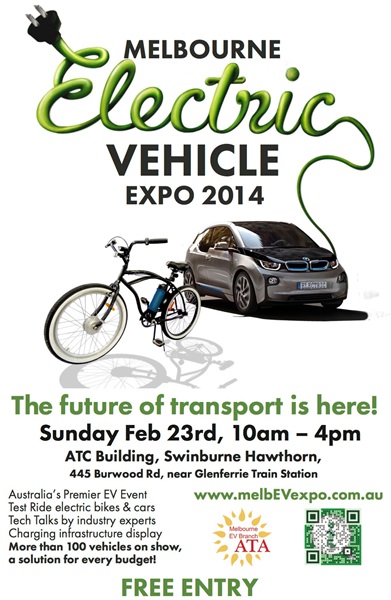
The premier electric vehicle event is on again.
Melbourne Electric Vehicle Expo.
On Sunday, 23 February you have the chance to test ride electric bikes and drive electric cars, listen to tech talks from the experts and view more than 100 vehicles at the ATC Building, Swinburne University, 445 Burwood Rd Hawthorn (near Glenferrie Train Station).
The expo, which is part of Melbourne Sustainable Living Festival, will also undertake a World Record attempt for the Largest Parade of Electric Vehicles.

Article from RoyalAuto online:
More power to the cyclist, say electric bikes fans, who see this assisted form of pedal power as a transport bridge between traditional bicycles and the car. Report: Georgie Haberfield
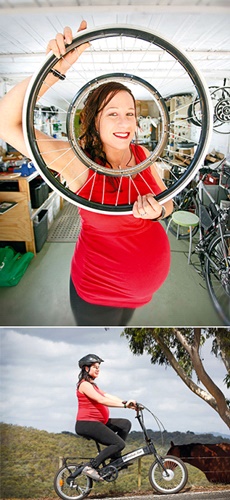
Rebecca Lee bought her first electric bike seven years ago, back when they were daggy. “There were only one or two suppliers, and they had pink or blue,” Rebecca recalls. “It was quite a heavy bike when it ran out of battery charge, which it did quite quickly.”
Over the years Rebecca’s electric bikes –or e-bikes, as many are calling them – have become lighter and better powered. When RoyalAuto spoke to her, she was eight months pregnant and really enjoying the motorised assistance to get around her hilly home suburb of Warrandyte.
Rebecca, 35, is one of a growing number of Victorians who are choosing e-bikes for transport and leisure. Retailers reckon sales have doubled in the past year for an item that can cost anything from $1200 to $3200.
Riders still have to pedal an e-bike, but the assistance the electric motor gives is the deal-clincher for many buyers.
Monash University’s Marilyn Johnson has followed the international trends. “Some of the stats will blow your mind,” she says. “There are 210 million electric bikes owned in China and, last year alone, their sales estimate was 33 million.”
The uptake of e-bikes in Italy and Germany now outstrips regular bicycles, and The Netherlands, Austria, Canada and the U.S. aren’t far behind.
While Australia is trailing that trend, its pace has quickened, particularly since the Federal Government in 2013 adopted a European design rule allowing e-bikes to be powered by 250 watts (the standard import size).
Marilyn, who is a research fellow with Monash’s Institute of Transport Studies and Department of Civil Engineering and a policy officer at the Amy Gillett Foundation, says an electric bike study of 529 people shows that access to electric bikes is attracting more people to cycling.
The study showed 88% of those who weren’t previously cyclists are riding their electric bike weekly and almost half are riding daily. “It’s a big, big shift,” Marilyn says.
“(People) would say it’s too hilly, it’s too far, they’re too unfit. And they’re really blunt, they say, ‘I’m too fat, I’m too lazy’. But then they’d ride (an electric bike) for the month and many of them enjoyed it so much they went on to ride a pedal bike.
“We also found they stopped driving cars as much. They were making a choice to ride the e-bike because they said it was really, really fun.”
People on e-bikes also feel safer, Marilyn says. “If there was a tricky situation they felt the extra power assistance would help them get out of it … and newer and older riders felt more comfortable about their fitness and safer in terms of getting to and from their destination and back.”
RACV has long been an advocate for safe riding and has provided education programs for schoolchildren. It has called for improved, separated, infrastructure for bicycle riding across Victoria which, if provided, would address the safety concerns of potential and current riders and drivers. Electric bikes could then address the concerns of some members who believe their personal fitness prevents them from riding.
“E-bikes may make bike riding an option for people who might not have considered it before,” says Dave Jones, RACV’s manager of roads and traffic. “Moving from your car to a pedal bike is a step too far for many people. E-bikes gives them assistance but also exercise.”
On an environmental level, supporting e-bikes is similar to RACV’s support for low-emission and alternative-fuel motor vehicles, which reduce the cost and environmental impact of motoring.
“Having access to an e-bike may reduce the need for households to own their second or third car, or help them to use their cars less,” Dave says.
The environmental benefits of an e-bike converted Rebecca Lee, and it gave her a new career. Rebecca and her partner now convert traditional bikes into electric bikes from their home.
“I’m passionate about environmental issues and I want to help people to help the planet,” she says. “It’s a good middle step between a car and a bike.”
E-bikes are now being supported by RACV’s Bike Assist program. For details, call 13 RACV (13 7228), visit your nearest RACV Shop or download a brochure from racv.com.au/bikeassist
TAKING IT TO THE STREETSChris Corr knew about e-bikes years before he bought one. He’d seen them around, and as the secretary of the Bendigo Sustainability Group (BSG) he keeps up with transport alternatives. But when he bought an e-bike for his family, bringing the number of bikes in the house to seven, his wife Karen was not convinced. “But that all changed when she had to revert to the electric (her bike had a puncture) and I haven’t been able to get it back since,” Chris says.
The BSG sees e-bikes as an important part of sustainable transport, and to promote this alternative it invested in an electric bike. The group recycled Chris’s bicycle trailer and refurbished it with all the bells and whistles, including a TV. “It is a conversation starter at events and a great way to get people interested in cycling and electric bikes,” Chris says.
He encourages everyone to get on an e-bike and try before you buy.
He believes that if you can give up the car, or even the second car, it is great for your wallet and waistline and helps the environment.
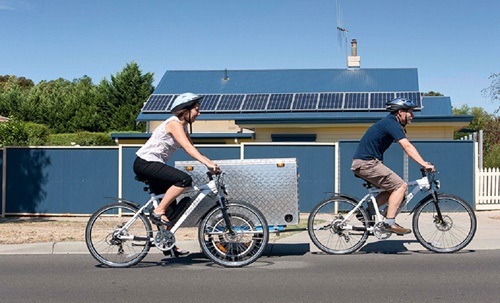
Giancarlo Zanol first saw an electric bike at an exhibition in his native Italy five years ago but it was no average electric bike. Instead of a front wheel, it had a ski plus what looked like a tank tread on the back. “I asked, ‘What is it? Does it go in the snow?’ ”
Giancarlo asked the exhibitor and learned the bike was a pure grab for attention. It worked – Giancarlo took the regular electric bike sitting next to it for a spin and was hooked. The hook, however, did not just include buying his own electric bike. He started a company.
“I was bored in retirement,” Giancarlo, 68, admits. “I was just bumming around.” On his return to Australia, he approached his son about importing electric bikes. “We imported 30, then another 20, and then started the shop.” Riding the e-bike craze, the two have had to move to larger premises.
Giancarlo gave up conventional cycling at 23, when he purchased his first car. He says he would never have switched back but for the electric bike. While he says he is hardly Tour de France material, he does put his bike on the economy setting to maximise his pedalling.
“You see the world differently by bike … you get to smell the roses.”
See www.dolomitiebikes.com.au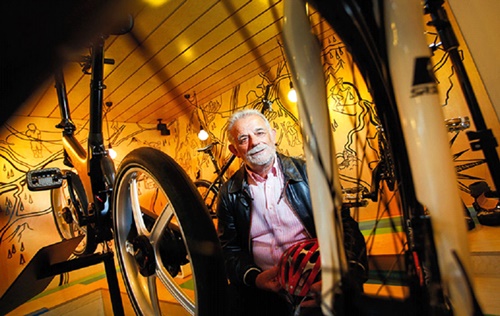
Electric bike users must remember to adhere to bicycle road rules, such as wearing a helmet that meets the Australian Standard and riding in a bicycle lane if there is one on the road. See VicRoads for more.
SAVE ON E-BIKES WITH RACVRACV members can now get discounts on e-bikes and other benefits through RACV’s Show Your Card & Save program.
Three e-bike retailers in Melbourne – Dolomiti in Ivanhoe, Velo in North Carlton, and Cargocycles in Collingwood – are giving members discounts on various models and products, plus anyone who buys an e-bike from these retailers gets a free one-year subscription to RACV Bike Assist. (Members who already have RACV Bike Assist will get a one-year credit on their subscription.)
For details, go to racv.com.au/sycas and click the Save On Your Shopping link. And keep checking, because new e-bike partners will be added soon.
RACV Bike Assist helps cyclists if their regular bicycle – and now e-bikes – can’t be ridden due to an accident, mechanical problem or puncture. If RACV’s mechanic can’t fix the problem, Bike Assist will call a taxi to get you and your bike to your destination. For details, call 13 RACV (13 7228) or go to racv.com.au/bikeassist.
RACV SUPPORTS CYCLINGRACV advocates for improved transport services and enhanced safety for all members, including bicycle riders. Almost half of all RACV members ride a bike; one in five do so at least once a week. Besides Bike Assist, RACV is involved in cycling in many ways.
RACV Melbourne Bike Share is a way residents, visitors and workers can get quickly through the city. There are more than 50 Bike Share stations in inner Melbourne. To find out more, go to www.melbournebikeshare.com.au. RACV Street Scene is RACV’s primary school road safety program that includes bicycle safety.
RACV is the major sponsor of the RACV Great Victorian Bike Ride – www.greatvic.com.au. This year’s ride, on 29 November-7 December, goes through Bright and the High Country. RACV is also the new sponsor of the Great Ocean and Otway Classic Ride, a one-day ride for all abilities each March.
CHOOSE THE RIGHT E-BIKELike conventional bicycles, e-bikes come in all styles, says Iain Treloar, technical guru with Australia’s leading cyclist magazine Ride On. There are flat bar commuters, downhill mountain bikes, recumbent tourers and folding bikes to stow in caravans.
Iain provides his top tips for choosing a bike.
1. Test-ride many models because there are many different styles on the market. Check riding positions to see what is comfortable.This depends primarily on the battery capacity, which is conventionally expressed according to its volts and amp hours. It’s handy to multiply the volts and amp hours together to express battery capacity with a single figure in Watt hours. As a basic guide, a 36V 10ah battery (360Wh), which is a common capacity for an e-bike battery, will take you 50km using the highest level of assistance or 100km using the lowest level of assistance. A 36V 9ah battery (324Wh) will provide about 40 kmor 80km and a 36V 14ah battery (504Wh) should take you 55km or 120km. Hills, headwinds and carrying a lot of weight drain the battery further, and using a throttle drains the battery more quickly than a pedal assist system does.
Is the battery charger Australian compliant?Most chargers are smart ones that you can leave on overnight, although most batteries charge in four to six hours. You can top up a lithium ion battery anytime but it’s best to charge it once it’s less than half full. Be aware that batteries have a finite life. You should budget to replace your battery after two or three years or 500 discharge and recharge cycles.
How easy is the display to use?The bit you interact with is the display, which is attached to the handlebars. It might have an LED screen and all the functions of a simple cycle computer laid out like a mini dashboard or it might be a simple box with LED lights to indicate battery and pedal assist levels. The best displays have up and down buttons to instantly adjust the level of assistance you want while riding. Basic displays, disappointingly including Gazelle, provide only one button and to go down an assistance level you have to scroll up and back to zero first.
How does the pedal assistance work?The final e-bike bit is hidden but crucial: the controller. It’s usually in the box with the battery. It translates the messages from the pedal assist sensors and the display to the motor but it’s also what governs when the assistance cuts out and subtle things like how gently the assistance starts so it’s not too sudden. Many controllers (systems) can be customised for your riding by the bike shop: providing more assistance for steep hills or providing less assistance for less battery use. You should ask your shop about tuning your bike to suit your riding.
THE WORLD OF E-BIKESRide On is the magazine of Bicycle Network Victoria. Below are more tips and reviews from Iain. These have been endorsed by Choice, Australia’s leading independent consumer guide.
Convert your own bikeConverting your own bike to an e-version gives you the most scope for choosing the style of bike you like and getting the right size – because most off-the-shelf e-bikes don’t come in different sizes.
There are several electric bike conversion kits on the market in Australia. The ones listed in the table at the end of this article are the ones Ride On is confident to suggest and they post Australia wide.
It’s not too hard to convert your own bike if you’re technically minded, though Bionx, for instance, is only available from a dealer who will do the installation for you. It’s advisable to have an experienced bike mechanic have a look over your conversion to be sure everything is good working order.
When you’re considering a conversion and choosing what bike to electrify, think about the variety of riding you will do with your newly improved machine. There’s a reason why so many European e-bikes come fully
accessorised with mudguards, chainguards and racks or baskets, it’s because these bikes are designed for the most utility for a wide variety of trips. Whether you’re riding in the wet, in office clothes, carrying luggage or shopping, these bikes are ready to aid your task.
All workplace bike fleets should include electric bikes. Employees worried about getting sweaty in transit to a meeting can feel assured if they can take an electric bike. Hire bike fleets should similarly include electric bikes.
Groups travelling together can accommodate a less confident rider, who can take an electric bike. Then that rider can feel sure that they can cover the distance and keep up with everyone in the group. This includes mountain bikes for hire, now that there are reasonable e-mountain bikes and kits such as Bionx to fit to existing mountain bike models.
Manufacturers need to test how people actually ride e-bikes. For instance, many people use the strongest level of pedal assist for most of their riding. Developers must understand and cater for this. At the very least, brands must express the realistic range that can be expected from the highest assistance level.
But the development to take e-bikes to the next level of popular engagement – to make the e-bike the second vehicle of the middle and outer suburbs of Australia – will be an automatic transmission that will do away with the complication of gears and levels of pedal assist. It will be a system that adjusts assistance depending on resistance such as gradient and headwind, supporting the rider to pedal at her/his preferred cadence and power. It must be possible and it would be irresistible fun.

Article from the Saturday Age Drive Section:
By Tony Davis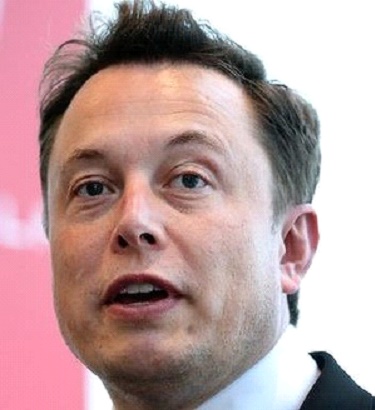
The most unlikely car mogul of all is South African-born Elon Musk.
He didn't grow up dreaming of being a car-builder, though as soon as he made a mint from flogging software companies he bought a McLaren F1 road car. And smashed it.
No, young Elon was obsessed by science fiction comics and video games. According to his mum, he had few friends at school and was widely picked on.
He left for Canada at 17 then moved to the US, gaining engineering and business degrees along the way. When he went into business, cars were a long way down the list.
While still in his 20s he sold a software company and pocketed $21 million. In 2002 he was the biggest shareholder in Paypal, which eBay bought for $1.5 billion.
Without pause, he moved into the space industry with the stated aim of making "human life interplanetary" with colonies on the moon and Mars.
He became chairman of Tesla Motors from early 2004, with the mission statement of completely changing the motoring world with new generation electric cars.
When a newbie turns up with a miracle vehicle that's going to whip the establishment, it usually ends quickly and badly. Musk, however, is still hanging in there.
Looking younger than his years (he was born in 1971), he speaks softly (usually) and with a neutral accent, probably cultivated when newly out of Apartheid era South Africa.
Musk's ambitions are literally out of this world, his employees talk with almost apostle-like respect, and during his constant working of the media (and tweeting) he talks about addressing "the future of the world, the future of humanity".
He can sound like a huckster selling hot air and/or a new religion. But his businesses have been largely funded, and on occasions rescued, by money he made in his early software days.
The technology he is developing, although sometimes controversial (particularly when he has obtained substantial US government loans), seems to work.
The SolarCity company he leads is the biggest supplier of residential solar panels in the US, his SpaceX rockets are being used by NASA, and the Tesla Model S sedan has drawn rave reviews around the world.
Tesla drivetrains are used by Toyota and Mercedes, both of which have invested in the US electric car company.
The first Tesla, a revamped and electrified version of the Lotus Elise called simply "Roadster", had mixed reviews. The $US100,000 price-tag was scary enough; it was later revealed that the materials alone cost $140,000. Yet Musk persisted.
Today's Model S – the name rather arrogantly alludes to Ford's Model T, that other car that changed the world – sells for about half as much as the Roadster. The next phase, says Musk, is a sub-$30,000 car.
When asked in a TED interview how he's achieved so much, Musk said: "I don't know, actually. … I work a lot."
He was eventually coaxed out to say that most people reason by analogy, in other words by "copying what others do with slight variations". While attempting something new, he uses physics as his framework.
"You know, the sort of first principles reasoning. What I mean by that is boil things down to their fundamental truths and reason up from there, rather than reason by analogy.
"Physics is really about figuring out how to discover new things that are counter intuitive."
The market is clearly entranced by such talk. It currently values Tesla at $27 billion, almost half as much as General Motors.
GM produces 10 million cars a year at a profit. Tesla makes 35,000 at a loss.

Choice Electric Vehicle review March 2015"
We take the electric Model S Tesla P85+ for a spin and declare it a 'game changer'.
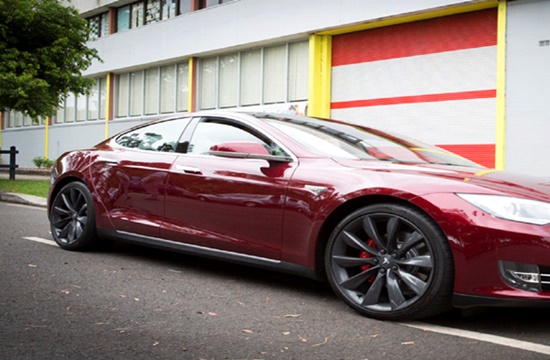
"Insane." "Freaking awesome." "I screamed a little." These are some of the reactions from the staff we took for a spin in a Model S Tesla, which accelerates from go to 'whoa!' (100km/h) in a matter of seconds. Meanwhile, CHOICE tester Peter Horvath took the P85+ home for 24 hours and didn't want to give it back.
Peter says:
Steering is very direct and it's nice to hold the leather steering wheel. It responds very well to flooring the accelerator when overtaking. While the ride is surprisingly firm, it's not uncomfortable. Presumably, it's designed like that to handle the power of the motor especially when cornering fast. The leather seats are very comfortable with multiple adjustments. It's very quiet on good roads, but there's a fair bit of tyre noise on coarser roads, possibly caused by the wide, large diameter (21 inch) and low profile (35) tyres on the car we drove. Also, there's a noticeable air-conditioner fan noise coming from the front especially at lower speeds.
There's a small boot in the front and a large one at the rear, plus the seats fold down to provide a lot of cargo space. We found visibility was good towards the front, but limited towards the rear due to the narrow rear window. There's a large digital display in the middle of the dash with reversing camera, which helps.
As you'd expect for the pricing, there's a formidable number of features – too many to fit in this article – but check out the Tesla website for the full list.
About TeslaAt the moment, Tesla is a rising name in the motoring industry. It's a small company, but growing, with some innovative ideas. One thing that kept recurring while writing this article is that the car is like the first iPhone – a game changer. It has over-the-air updates to software, a Telstra 3G connection that's free for four years, and a 17in touchscreen for controlling virtually everything in the car. It's intuitive, and Tesla keeps making changes to the software in response to what their customers want. Just as the iPhone changed everything about phones, the Tesla has come up with some innovations in car design that other motoring companies simply can't afford to ignore.
The downsideThe Tesla we drove is rated for 502km per full charge, but realistically you'll get about 300km and probably less if you have a lead foot. This is more than any other electric car in the Australian market, but it still might create 'range anxiety' for some people depending on their driving habits.
There are two Tesla 'Superchargers' in Sydney, with more to appear throughout Australia soon. These free charging stations recharge the car battery to half full in 20 minutes. You get a charge point to install at home, but you'll need a power point in the garage or charging area.
The verdictA very nice car to drive, suitable for lead-footed drivers who demand and enjoy instant power. It's not suitable for long-distance drives as the battery needs charging frequently. However, depending on the charge setup you have and the expanding network of Superchargers in Australia, a Tesla for long distance driving may be viable in the future, and the freedom from petrol will be appreciated by some. With all wheel drive versions, the 85D and P85D, being released this year, we look forward to testing later models in the near future.
Details


The American electric luxury car comes with plenty of hype.
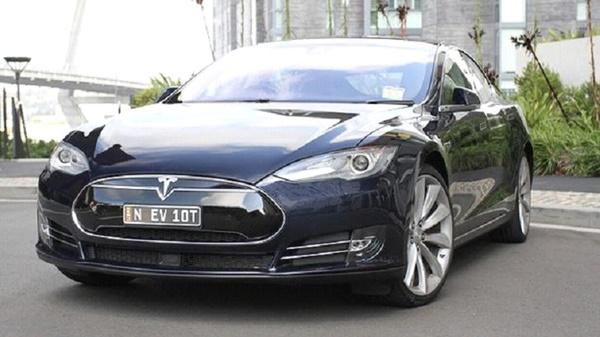
Few cars have arrived with the hype of the Tesla Model S. The American company – founded by PayPal co-founder Elon Musk – brings Apple-style "wow factor" to the car industry with its ground-breaking fully electric sedan.
It's the first all-new car the company has built following its initial Lotus-based Roadster and has caused a stir not just with consumers but also established car makers. Audi, BMW and even Porsche are believed to be preparing electric rivals to go up against the Model S in the coming years.
But does it live up to such hype?
What do you get?
The Model S range starts at $102,347 (plus on-road costs) for the P60, which is equipped with a 60kW/h battery, but we're testing the P85, a 85kW/h equipped model which is priced from $119,348 (plus on-road costs).
Customers can also order the new range-topping P85D which adds a second electric motor on the front axle to up performance and starts at $160,557 (plus on-road costs) but those cars won't start arriving until September.
All cars are covered by an eight-year, unlimited kilometre warranty for the battery and drivetrain.
The P85 comes enabled for Tesla's new Supercharger network, a series of rapid charging stations that will be placed at strategic locations on the east coast of Australia by the end of 2016.
While the Superchargers are thin on the ground now they allow Tesla owners to get free recharging, and as an added benefit free parking in the CBD of Sydney and Melbourne.
The Superchargers are able to recharge more than 50 per cent of the battery in approximately 20 minutes.
Buyers also get a wall-mounted recharging unit for their house included in the price of the car.
All Model S' also get a 17-inch touchscreen in the centre of the dash that controls all the car's major functions, including airconditioning, entertainment, navigation and car controls.
Other standard items include 19-inch five-spoke alloy wheels, Bluetooth, lane departure warning, speed limit display and LED daytime running lights.
Tesla has also announced it will buy any Model S back from customers between 36 and 37 months of ownership for 50 per cent of the base price of the 60kW/h models plus 43 per cent of all options including the upgrade to the 85kW/h battery.
Tesla also "pushes" regular software updates to the car to offer improved functionality, similar to modern smartphones.
What's inside?
The interior is dominated by the huge touchscreen, both from a design and functional point-of-view.
It marks the Models S as a radical departure from traditional car design but isn't just a gimmick. It is actually a very easy-to-use system with simple, smartphone-style navigation and plenty of customisation.
The rest of the car is more conventional and the indicator, wiper and cruise control stalks behind the wheel are borrowed from Mercedes-Benz, as are the power window switches.
The leather seats are supportive but sit too high, lack bolstering, and can feel firm after a long trip.
Small item storage is limited too, with just a small glovebox and two cupholders. There is a large, open area on the floor between the driver and passenger seats with non-slip material but there's not much protection to prevent large items from sliding out under heavy cornering.
Overall space for occupants is good though with good head and legroom front and rear.
Luggage space is excellent with 924-litres split between a 744-litre rear boot and 150-litres under the "bonnet" in the front.
Under the bonnet
This is where the Model S is unlike its rivals from Europe and Japan. A 285kW electric motor is mounted behind the rear seats and sends power to the rear wheels.
The batteries are spread across the floor of the car to keep the weight low and not interfere with interior space.
Tesla claims the Model S P85 has a range of 502km, but in the real world expect a usable range closer to 400km, which is still significantly ahead of any other full electric vehicle.
But the Model S isn't just about skipping the service station, it also offers up serious performance – 441Nm of torque available from 0rpm.
As soon as you put your foot down the Model S launches with serious intent. The company claims the 0-100km/h sprint comes in just 5.6 seconds and it will manage a top speed of 225km/h.
On the road
The Model S feels like a modern luxury car on the road with a quiet ride and a mostly comfortable experience.
The floor-mounted batteries means it handles the bends well given it weighs more than 2000kg.
But there are some signs this is the first car the company has built. Even on the $2900 optional Smart Air Suspension (you can raise or lower the ride height via the touchscreen) the ride can be firm at times.
The steering also lacks the same fluid response its more experienced automotive rivals offer. But for the most part it is nicely weighted for urban driving.
The regenerative braking can be tailored depending on your preference but if you can get used to the standard setting you'll find yourself using the brake pedal a lot less than in a conventional car.
Verdict
The Model S manages to live up to the hype with its blend of cutting-edge electric vehicle technology, slick design inside and out and competitive pricing compared to its European rivals.
There are still some areas for improvement but for a first-up effort the Model S has raised the bar for what you expect not just from an electric car but also a modern luxury car.
Tesla Model S P85 specifications
The following article is from the Saturday Age Drive Section:
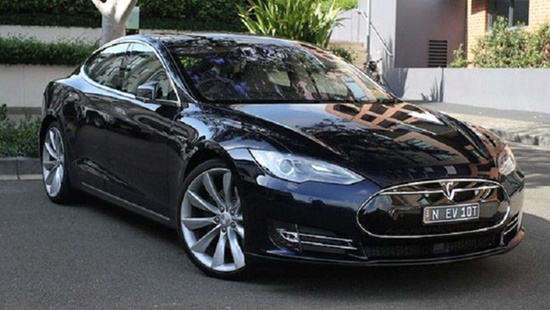
Modern luxury: The Tesla Model S. Photo: David McCowen
The car: Tesla Model S P85He: A few months ago we drove a traditional car maker's take on the future of (almost) petrol-free motoring, the BMW i3 and we were both pretty impressed. This is Silicon Valley's take on the electric car. Built by the start-up car brand in California headed by the colourful, Tony Stark-inspiring Elon Musk the Model S arrives in Australia with plenty of hype and expectations. What was your first impression?
She: Ay, caramba! What a looker. What a player. Those disappearing door handles, that interior blue glow, the mini-me keyless fob-toy-thing, the absolutely, stonkingly, gigantic display that hovers like a centrepiece in what feels like a classy Singaporean hotel cocktail lounge. This is a car that got expelled from primary school and then re-wrote all the rules to suit itself. And all those who can afford its sublime two-fingers-up-to-the-naysayers braggadocio.
He: It unquestionably makes a statement. The design is so modern and unlike anything else on the market it almost makes its environmental credentials irrelevant. But then you drive it and… wow! When I picked it up the guy said it was the "second least powerful model" they sell. Well you can't tell when you press the go pedal, the P85 launches with ferocious acceleration. Did the performance blow you away as much as the looks obviously did?
She: Not so much the looks, because, actually, it's quite an executive looking thing from a distance, but the whole shebang - the getting in, the way it comes alive, the attention to detail, the whole catastrophe. It's really special. Behind the wheel, it's space agey, with that huge screen fast becoming a friendly presence in the process, quietly blinking my energy levels, battery power and all other vital stats as we hum along. Totally different to the i3, this feels more like a traditional car to drive, giddily fast at take off but with heaviness in the steering and, owing to its imposing size, not quite as nimble. From the outside, it's like a shark, coming from nowhere with sleek elegance - we got a lot of looks.
He: You make a good point about the screen. When you first get in you think that huge 17-inch display will be a massive distraction and a pain to use - but it is the total opposite. It is actually super intuitive and very handy. It not only displays maps and the audio system it can also display loads of useful data about the batteries and how much electricity you use. And did you notice the navigation calculates its routes to avoid hills that can sap the batteries and then calculate how much energy you'll have at the end of the trip - very cool. But I was pretty disappointed with the amount of storage space in the cabin - two cup-holders! Surely they could have been a bit smarter with the layout?
She: The Tesla is as much a computer as it is a vehicle, and a clever computer at that. I'm convinced there must be something more to that imposing central island than two measly cup holders - what are we missing? I loved how boastfully minimal it was - but then, this probably isn't a car for the morning commute to the kids' schools, via kindy, the coffee shop and the dry cleaner. Aesthetics aside, what did you make of the drive - especially as, unlike me, you've had a chance to sample the full might of the P85's shriek-inducing torque?
He: It is a very strange experience because the Model S launches with the force of a big V8 or turbocharged engined car - but it does so without making any noise. Or no significant noise, just a gentle hum from the electric motor behind the rear seats. It also does a good job of disguising the weight of the car, it tips the scales at more than two tonnes, or at least it does in a straight line. Once you throw the Model S at some corners it feels big - but it is still well composed and controlled. Overall its a very nice car to drive. I'm a big fan of its performance, looks and technology and would happily have one in the garage. You?
She: Very happily, Steve, although this kind of clever car comes with a price tag that only the most privileged can realise. It's such an dynamic time in electric car technology and I hope we'll soon see the futuristic characteristics of the Tesla rolled out to the masses and reshaping the way we all look at getting about. In the meantime, I need to purchase a lottery ticket and a garage.

The following article is from the Sydney Morning Herald:
 By Hannah Francis
By Hannah FrancisFrom reducing power bills to revolutionising our dependence on fossil fuels, people are expecting big things from Elon Musk's latest offering.
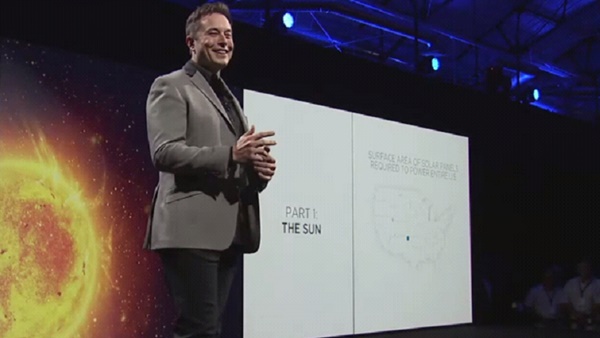
Billionaire Elon Musk is in the business of big ideas, from electric cars to space travel. But his latest venture, affordable batteries to power homes and industry, might be the biggest yet.
What is the Powerwall, and the Powerpack?
On April 30 Musk unveiled two new batteries that can store electricity from either the grid or a renewable energy source like solar.
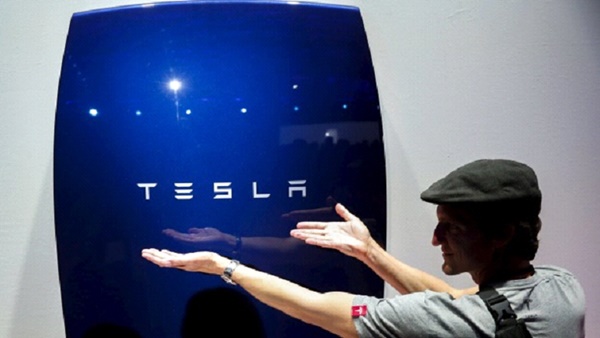
The Powerwall is a compact, wall-mounted, rechargeable, lithium-ion battery designed for homes and small businesses. Most existing systems for home power storage use lead-acid batteries, which require much more space and, in some cases, maintenance.
Powerwalls will come in a range of colours and two sizes – 7 kilowatt-hour and 10 Kwh. The units can be stacked together to increase power capacity. A typical four-person Victorian home uses between 16 and 20 Kwh a day, depending on the season.
The Powerpack, meanwhile, is a larger unit designed for utility scale, and can store 100 Kwh.
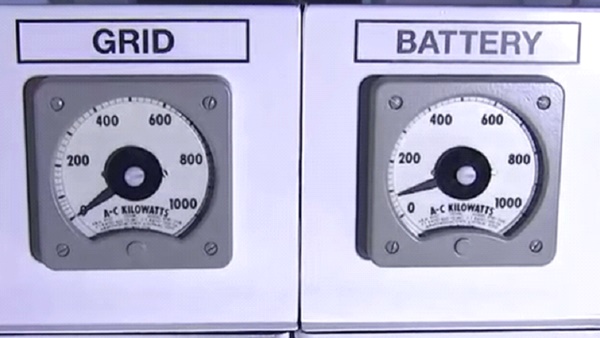
What's the appeal?
The Powerwall can be used for "load shifting" in the home, and also to provide back-up power in the event of an outage.
Load shifting is about spreading energy use for maximum benefit. For instance, if electricity costs more during peak periods, it makes sense for the household to charge the battery during off-peak times when the price is low, and then switch to battery power when tariffs are high.
For households with solar, unused extra power is often sold to their power company. With a battery, however, they can store the excess power generated during peak production times in the middle of the day, and use it after dark when demand is greatest. One Australian alternative technologies website calculated a single battery could cut use of mains power to 8 per cent a day.
Another advantage for Australians is that power companies pay households less for their excess solar energy than they charge them to buy power.
What makes them different to other batteries?
There are batteries that can match the Powerwall's performance, but what has people's jaws dropping is the price.
When Musk announced the 7 Kwh and 10 Kwh units were priced at $US3000 and $US3500 respectively (plus installation), his audience erupted with applause. Some had been expecting a price point in the tens of thousands.
Tesla is building a $US5 billion, 10-million-square-foot "gigafactory" in Reno, Nevada that will allow mass-production of the batteries and keep costs down.
What does it mean for big power companies?
Many pundits argue the utility-scale Powerpack will be more disruptive than the home battery.
Electricity companies typically need to be able to generate enough power to serve their customers during peak periods. Yet off-peak usage is generally only about a third of the maximum, and it is costly to ramp-up generation to meet daily peaks.
Battery storage gives power companies additional reserves to draw upon, meaning they don't need to invest as much in generation capacity. In addition, they increase the reliability of the grid with back-up power.
Studies in the United States have shown using batteries in this way will save power companies money, potentially bringing down electricity prices for consumers too. Some have suggested that, at scale, the technology will be more cost-effective than building new power plants.
And for renewable power companies, having storage capacity means being able to overcome the problem of an intermittent and unpredictable power source.
What does it mean for business?
At scale, Tesla's batteries become even more compelling, and there are already plenty of companies lining up to prove it (Musk's presentation was run completely on stored power).
Retailer Walmart and cloud storage provider Amazon Web Services are already using them to improve the reliability, and reduce the costs of, their power usage. Eleven of Walmart's California stores have been trialling the batteries, and AWS says it eventually wants to power all its infrastructure with 100 per cent renewable energy.
In terms of the industry size, one US study showed energy storage grew 40 per cent to $US128 million last year, with three times as many installations expected in 2015.
GTM Research forecasts the overall market will be worth $US1.5 billion as soon as 2019.
But even Musk himself doesn't want to go it alone – he is encouraging competition.
The jewel in the crown is that all Tesla's technology is open source, so anyone can reproduce it.
Can it really make living 'off the grid' an affordable reality?
A single Powerwall isn't big enough to power your whole home. If you're willing to pay for it, the batteries can be stacked next to each other to increase capacity, but there's still the cost of a solar system to generate the power. At the moment it's still cheaper to stay on the grid.
Power pricing is also a complex beast, however, and there are many factors with the potential to shift the attractiveness of home power storage, including a reduction in the cost of batteries once mass-production begins.
Another factor is that energy reform in Australia is likely to make variable tariffs for peak and off-peak periods more common, so storing power in the home at off-peak prices will be more attractive.
When can I get one?
United States residents can already reserve a Powerwall online – in fact, some 38,000 have already, according to Tesla. Shipments are due to begin around August.
Tesla says Australians will be able to get the Powerwall in the first quarter of 2016. The availability of the Powerpack is unconfirmed.

The Age editorial:
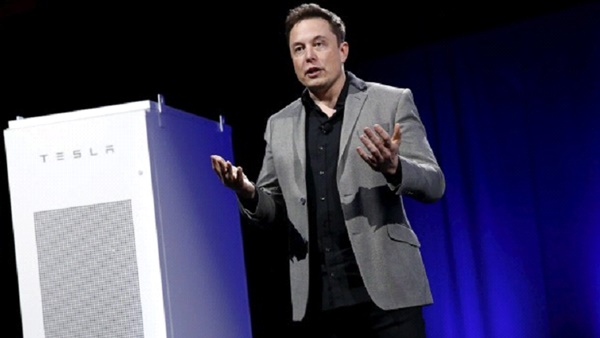
It really is a no-brainer. The sun is going to be around for about 7 billion years, scientists estimate. For the purposes of the human race this could be classed as eternity. Coal and oil reserves are forecast to last possibly a few centuries, at best. The latter two will run out. This is not speculation. They are not renewable.
The energy from the sun, while not renewable, is of such a vast reserve it does not need to be. As a measure of its size, if the sun were hollow, more than 1 million Earths would fit inside it.
How can it then make sense not to use this source of energy? How can it then make sense not to invest in the infinite – and we mean this literally – possibilities of solar power? It doesn't. And yet enlightenment seems a galaxy away.
It should come as no surprise, yet is still does, depressingly so, that consensus among nations as to how to tackle climate change and the inevitable depletion of resources goes around in circles. The move to renewable resources of energy stalls under the weight of short-term political manoeuvring – often hostage to industry lobbying – to maintain a status quo that puts the environment and the future last.
The Abbott government through its funding cuts and scant regard for science and research has relegated the search for answers to the bottom drawer.
It is just as well that there are alternatives to political short-sightedness. One such example is the vision of Elon Musk, an American renewable power billionaire, founder and chief executive of Tesla.
The company, which in the first quarter of this year also made 1000 electric cars per production week, recently launched its Powerwall system, in effect, a lithium-ion battery that can store 10 kilowatt hours of electric energy that has been generated by solar or wind power. The problem up to this point has been the lack of storage. Tesla has already received 38,000 orders. There is also a commercial version called a Powerpack, which can store 100 kilowatt hours. It does not take much imagination to see the potential.
Certainly not from Mr Musk: he believes 2 billion Powerpacks would meet the world's needs. It would be "a fundamental transformation [in] how energy is delivered across the Earth. That may seem like an insane number. But this is actually within the power of humanity to do."
Mr Musk's verve shines a light on the chasm between politics (described by Otto von Bismarck as not an exact science but the art of the possible) and technology entrepreneurship (which could be described as the art of the impossible).
On Friday, the Abbott government and the opposition agreed in principle to cut the target for renewable energy from 41,000 GWh to 33,000 GWh. Twenty per cent of Australia's energy is required to come from RET by 2020.
As a message to the world, this is hardly inspiring. As a message to the coal industry (which Mr Abbott embraces) it is good news. Now that an agreement has been reached, investment might begin again in the renewable energy industry. It needs to: a Senate estimates committee heard recently that the inaction caused by the government ordering a review of the RET has set the industry back 12 years.
This is not how to approach the future. This is not how to embrace change.
As the Tesla battery has shown, given the will and the investment, science will out. Breakthroughs in energy supply, such as the storage battery, will be the driver to sustainability.
It is up to governments to acknowledge this, and to back it.

Letters in the Sunday Age:
US company Tesla has just released a battery pack system for domestic use ("Why Tesla's battery is a big deal", 10/5). What is now becoming increasingly apparent is that with the government's championing of coal at the expense of renewable technologies, we are backing an inefficient, outdated and dirty energy source. As industrialised countries the world over embrace clean energy technologies (in Germany, 30 per cent of power comes from renewable sources), Australia will be left behind, potentially with stranded assets. We'll also have missed out on opportunities in the expanding new industry, with manufacturers placed at risk due to a lack of willingness by government to resolve the furore over the renewable energy target and look to a clean energy future.
Dennis O'Connell, Ivanhoe
Unfortunately, the 10Kw Tesla battery is only warrantied for 50 cycles and so of little use beyond 50 days of solar charging, although handy if there is a blackout. The smaller "7Kw" has also been canned by executives of Tesla's associate company, the panel installer Solar City, who say it is "unsuitable" for solar storage. This is mildly astonishing as Tesla's chairman, Elon Musk, is also chairman of Solar City. The problem is that due to lithium's high energy density but poor staying power, Li batteries run down after a few hours. No good for the freezer or today's watt-hungry TVs. The household still must be on the grid and in the US grid power is half the price of here.
Meanwhile, an Australian flow battery about to be mass produced in Mexico has been cycling every day for three years without fail and produces steady, consistent current. It can be fully discharged and then fully recharged to supply current almost ad infinitum. So it remains disappointing that while Australia has long led in this field, with our technology lauded offshore, local inventors find it near impossible to get their product manufactured locally. The Vanadium Redox flow battery, for example, is now well established in China but, like current flat panel solar technology, had its origins at the University of NSW. In contrast to the Tesla hoopla, our zinc bromine flow battery looks a dull work-horse, but it works.
Richard Campbell, ToorakThe Sunday Age (10/5) had three significant contributions about solar power; the first applauded Germany's renewable energy progress, the second highlighted power storage, while the editorial reminded us of how far behind environmentally are the Coalition and Labor. The Coalition's policy is to ignore global warming by supporting coal mining and coal-powered electricity generation. My partner and I, pensioners, have used solar power for 20years and were finally rewarded with a feed-in tariff of 66 cents per kw hour. However, when we downsized to a new house in the country the tariff was cut to 6.2 cents. Our smart meter informs us that we export three times more solar energy into the grid than we take from it. We are paid 6.2 cents and have to pay 30 cents. We, and Australians, are being ripped off. It seems that, like Germany, we need more green representatives in government.
Brian Moynihan, Castlemaine
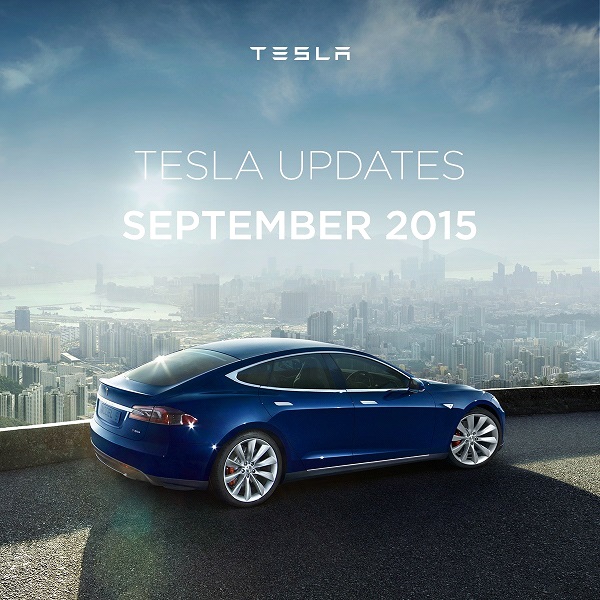
This week, the Model S P85D earned the highest rating ever in the 80 years of vehicle testing by Consumer Reports, scoring an initial 103 on their 100-point scale.
Since the Consumer Reports test, Tesla has further upgraded the Model S with the 90 kWh battery pack, increasing range by 6%, and Ludicrous Speed, which improves acceleration by 10%. Read what Consumer Reports had to say about P85D.
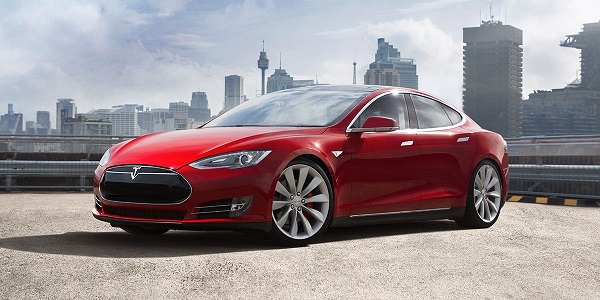
The Model S All-Wheel Drive Dual Motor line-up has reached the Australian shores and are available for test drive. Register for a test drive today to experience the great value of the 70D, the extended range of the 85D or the Insane acceleration of the P85D.
Range upgrade to a 90 kWh battery increasing your range by about 6% to 90D, and Ludicrous Speed Upgrade decreasing your speed from 0-100km/h to 3.0 seconds creating a P90D are both available for design and order.
TEST DRIVE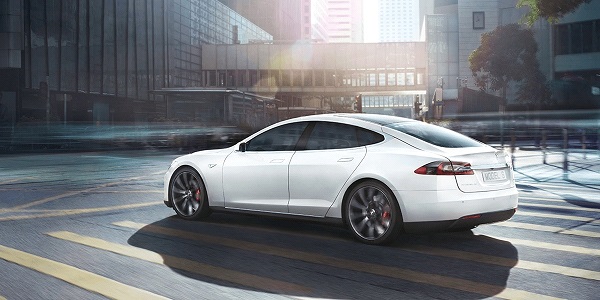
Common evaluations of Model S vs. petrol cars often overlook the full economic advantages of going electric: they look at cost of purchase but not the true cost of ownership.
Running cost savings are considerable. The average person drives approximately 15,000km and spends around $3,100 on fuel annually. In comparison, the cost of electricity to power Model S over the same distance is nine times lower. Over the five year average length of car ownership, that’s approximately $14,000 in fuel savings.
Also, electric cars typically require less service than petrol cars, delivering further savings through the lifetime of ownership.
All of these savings make the transition to EV a compelling proposition.
Model S now starts at $106,100 RRP plus on-road costs and taxes. With a Tesla Finance option, you also have the option of the Resale Value Guarantee.
TEST DRIVE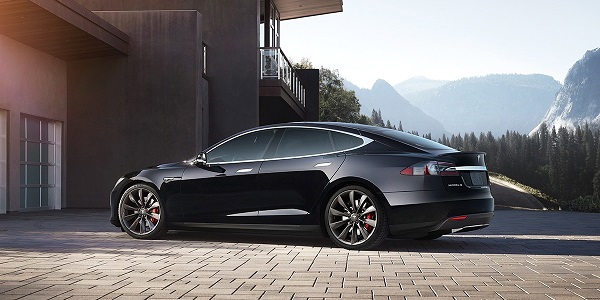
One of the great benefits of owning Model S is home charging. Simply plug in when you arrive home and Model S will charge right away or at the time you’ve scheduled using the Touchscreen or Mobile App. Long before morning, your car will be fully charged for the next day.
Our expanding global network of Superchargers, over 500 as of today, replenish half a charge in as little as 20 minutes. They are strategically placed to enable long-distance travel, typically located off major highways near shopping centers and travel plazas. Soon to open sites include Goulburn, Gundagai and Wodonga.
A growing number of hospitality properties offer charging as an amenity. Simply drop the car off at the valet stand. When you return, Model S is refreshed and ready for the road ahead.
FIND A CHARGING LOCATION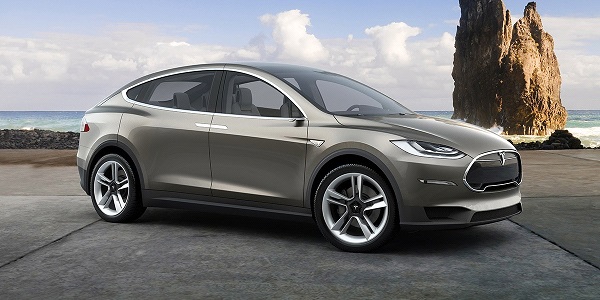
We are building and testing Model X prototypes and on track for first deliveries in late Q3 of this year in North America. We have made significant progress on the installation of a new body shop, a new paint shop and new stamping presses that will establish new capacity for both Model X and Model S.

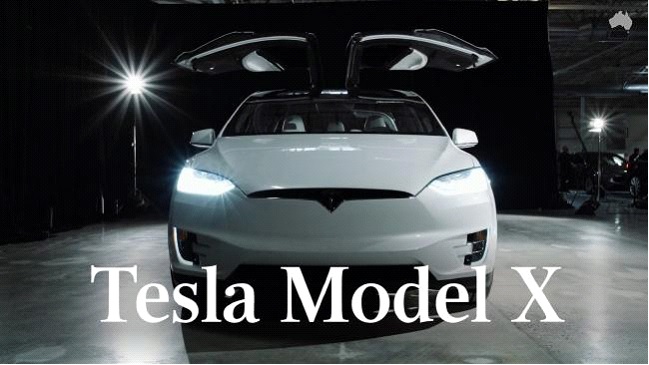
Aliens have landed — Tesla’s new Model X has touched down in Australia.
The futuristic vehicle with its dramatic “falcon wing” doors that open skywards is like nothing else on the road.
For a start it’s the fastest SUV ever built. The family-friendly seven-seater sprints from zero to 100km/h in a claimed 3.1 seconds, quicker than some Ferraris. And the EV has a claimed range of more than 500km, the same as a petrol-powered SUV.
The minute you approach the Model X, it’s clear this is no ordinary car. As you walk up with the key still in your pocket, it opens the driver’s door.
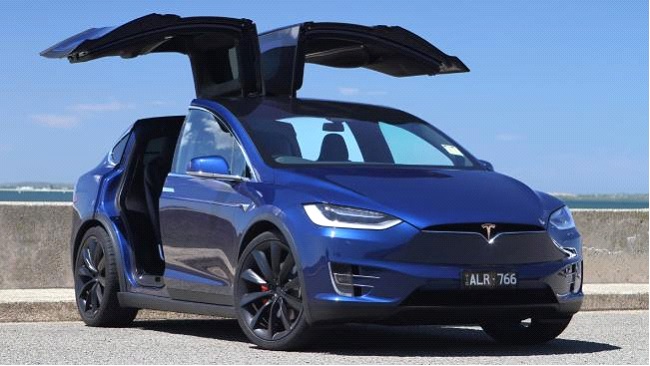
Once you’re inside there’s no need to turn it on or select a gear — simply put your foot on the accelerator and you’re off — like a scalded cat.
The takeoff is so brutal, it should come with a warning label for pregnant women and people with back complaints. You’re shoved hard into the leather seat and there’s a silent, relentless surge of power that’s more like an amusement ride than a conventional car.
And that’s before you select “ludicrous” mode. Tesla is a tech company first and a vehicle maker second, so the Model X has plenty of “geek” appeal.
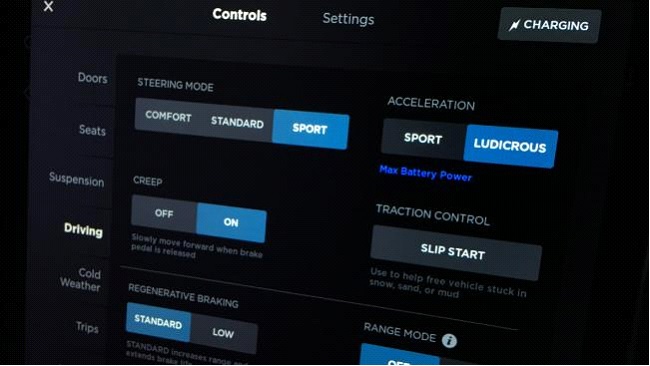
Push the “Ludicrous” button and it unlocks more power. Hold it down for a few seconds and it unlocks a hidden feature — Tesla calls it an Easter egg — that turns up the wick even more.
You know you’ve unlocked it because the huge, iPad-like centre screen looks like you’ve selected light speed on the Millennium Falcon.
Then you have a choice between two buttons — “I want my mommy” and “bring it on”.
It’s about then you start to wonder if this is the right message to be sending to the driver of a family-focused SUV.
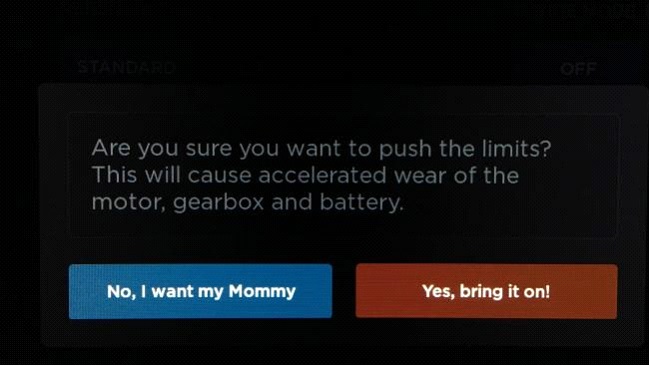
Thankfully, acceleration is not the Model X’s only drawcard.
The claimed range of 546km is by far the longest claimed by an electric production car and the company claims it will have the ability to drive itself when future software updates are released.
For now, though, our test car has none of the “autopilot” features that have made headlines — for both the right and, tragically, wrong reasons — overseas.
In the United States authorities have just completed an investigation into the death of a driver whose Tesla crashed while on Autopilot. They found no defect with the system, but Tesla upgraded its software in response to the accident.
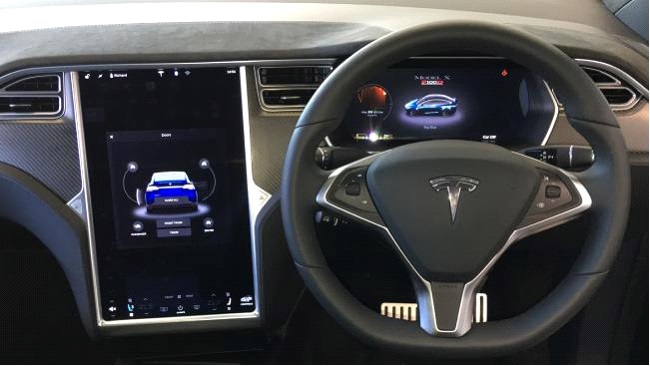
All the hardware — cameras, sensors etc — is in place, and customers can order the autopilot option now and receive the software update later. It’s not cheap, though. For those who pay for it upfront — before it’s available — the cost is $7600. Pay later and that cost rises to $9100. Full self-driving is another $4600 upfront or $6100 later. When you consider that self-driving is “pending regulatory approval” you’re taking a bit of a punt.
Elsewhere, the Model X feels relatively normal, aside from the doors of course. At the press of a button they lift up like a bird about to take off. It’s an impressive feature — and they only need 30cm of room to open — but you wonder whether the novelty would wear off after a while.
The centre screen, which debuted on the Model S, is easy to navigate and is linked to Google Maps and Google Earth. The infotainment system is wi-fi enabled and you also get a complimentary Spotify subscription, with free data for four years.
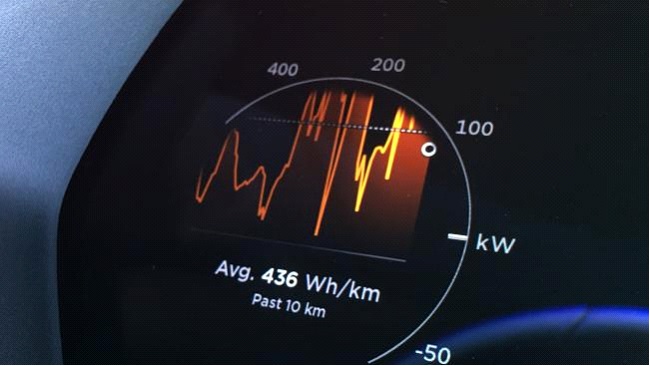
It’s not as practical as other high-end SUVs though. The second row seats don’t fold flat for bigger loads and those doors mean that roofracks aren’t an option.
Third-row seat occupants sit under the glass of the steeply raked tailgate, which could get uncomfortable in summer. The same goes for the front, where there is a huge front windscreen. It might seem like a little thing, but having to pump up the aircon zaps your range and power noticeably.
On the plus side, access to the third row seats is easier than other seven-seaters and you can seat adults in the third row. You also have extra luggage space under the bonnet.
As a driver, the Model X experience is top notch.
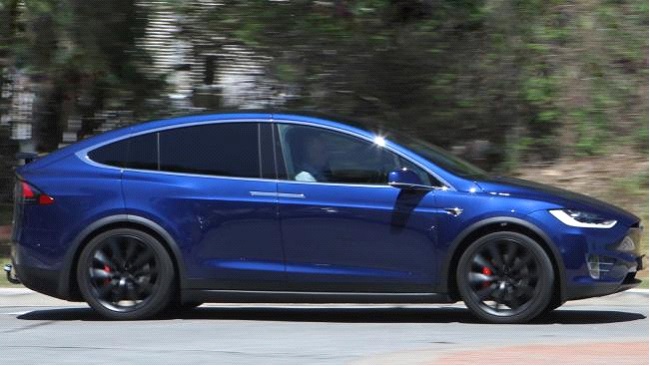
Forward vision is good and the suspension glides over all but the sharpest of edges in the road surface. It’s well controlled too, settling quickly after a big bump at speed.
Head for the curves and the Model X continues to impress.
You can still feel the weight of the car under braking, but through the corners it resists that top-heavy lean you get with most big SUVs, thanks to the huge slab of batteries in the floor of the car.
The brakes are strong and the acceleration is expletive-inducing.
Our only gripe was the range, which didn’t get anywhere near Tesla’s claims.
When we picked the car up it had an estimated 487km left. We took it on our normal 150km test loop, which includes an equal split of city traffic, freeway driving and secondary country roads. At the end the range was 222km.
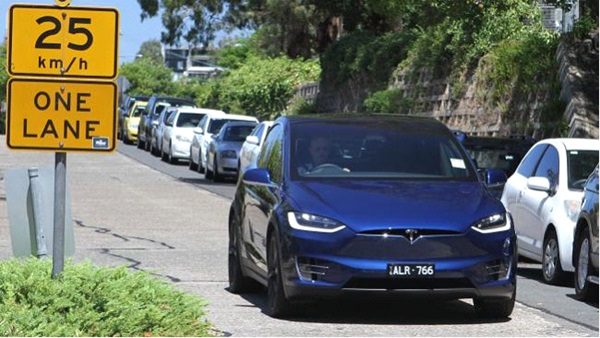
This isn’t unique to electric cars — petrol cars understate their range as well, but the discrepancy was far more pronounced.
After a series of roughly 8-10 “ludicrous” launches and some more city driving, we returned to Tesla head office with 237km on the trip computer and 7km left to empty.
Then there’s the price — our test car was $305,000 on the road, so while it may an enticing option for the rich, it’s hardly going to revolutionise our car buying habits.
That said, it is an exciting glimpse of the future.

Editorial from The Age newspaper:
Of the 1,145,024 new cars sold in Australia last year, a mere 219 were electric and 12,625 hybrid. Yet all cars sold in Australia are likely to be purely electric far sooner than such starkly contrasting numbers might suggest. The issue is not whether the internal combustion engine, one of the most transformative technologies in history, is set for extinction, but how fast and how well the transition to electricity happens.
The Australian government is looking far from agile so far in this global public policy conundrum. It is crucial businesses be given certainty so that they can have the confidence to make the necessary investments in design and in the national installation of recharging infrastructure. Failure by the Coalition government to provide such certainty through policy stability has been the biggest brake on investment in the renewable energy that, combined with electric cars, will be fundamental to the commitment Australia has made internally and internationally to reduce carbon emissions.
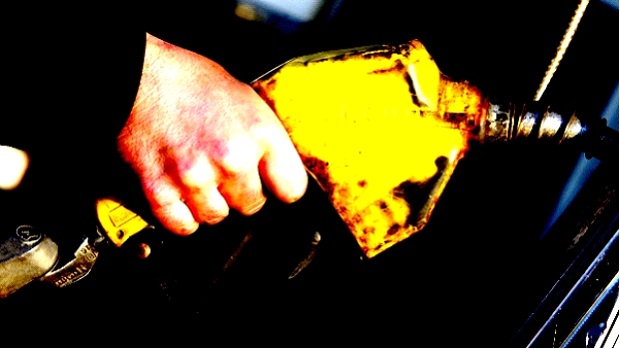
The government might do well to plug into policies driving the demise of the fossil-fuelled car, for they are being welcomed by manufacturers, designers and software engineers the world over. Key among such strategies is committing to a date after which all cars sold must be electric. France and Britain, for example, have nominated 2040. Other incentives to smooth the transition might include bonus payments or exemption from luxury taxes. Such incentives have been introduced in all the nations of Western Europe.
Rapid advances in battery technology and falls in the price of electric cars and of renewable energy are speeding the end of the internal combustion engine's era.
The environmental, economic and health rewards of this inevitable change are massive and evident. There might well also be profound social benefits. The switch is coinciding with the popular embrace of ride-sharing and the imminent advent of self-driving cars. Currently, most cars spend 95 per cent of the time parked, and most commuters are alone in their vehicles. It is not hard to envisage freeways that actually flow with cars with multiple passengers.
There are about 1 billion cars in the world, of which 2 million are electric. More than a third of those electric cars were sold in 2016. The rate of growth of such cars is poised to accelerate sharply.
Smart phones have been around for only a decade but are ubiquitous and have revolutionised the way people live. The change to electric cars is likely to be similarly momentous and rapidly integrated into our routines.

The following video comes from Truthdig from an article by Juan Cole on 7 MARCH 2018 from the Wall Street Journal in 2017:

The Electric Vehicle saga in Australia would be funny if it wasn't so tragic! Suddenly in March 2019 the federal governamnt and its loyal opposition have suddenly discovered electric vehicles and are starting to re-invent the wheel. The tragedy of it is that if they had taken notice of what was happening in the car world outside their little closed world called Australia, they would have managed to adapt the manufacturing industry of car manufacture in Australia and adapt those plants to produce electric vehicles. As it happens in reality, Australia is lagging behind the rest of the manufacturing world and won't be able to catch up for a long time. Infrastructure needs to be provided and the public needs to be educated to understand what is happening elsewhere. Of course they will be expensive to start with because the numbers are so small, but if they had shown interest at least 10 years ago, all of the requirements would already have been in place and electric vehicles would be able to be sold at competitive prices. Think about Australia and transport in general and realise this country is at least 50 to 100 years behind.
This article was in the Drive supplement of the Sydney Morning Herald and The Age on 28 Mar 2019
The EVs you need to know about - now!
We look at the electric cars that are charging down under.
1 / 1 photosLike it or not, electric cars are the future.
Just this month Volkswagen announced its goal is to sell 22 million electric vehicles by the end of the next decade, Audi hinted the next R8 supercar is set to be battery powered, Mercedes-Benz Australia gave interested customers a first taste of its EQ C and Hyundai launched the Kona electric into local showrooms. Change is happening, and it’s happening fast.
The electric car isn't a flight of fantasy, or a quirky green-tinged alternative anymore, with a new wave of electric vehicles charging onto Australian roads in the next 18 months. So here are eight EVs that you need to know about now.
Hyundai Kona Electric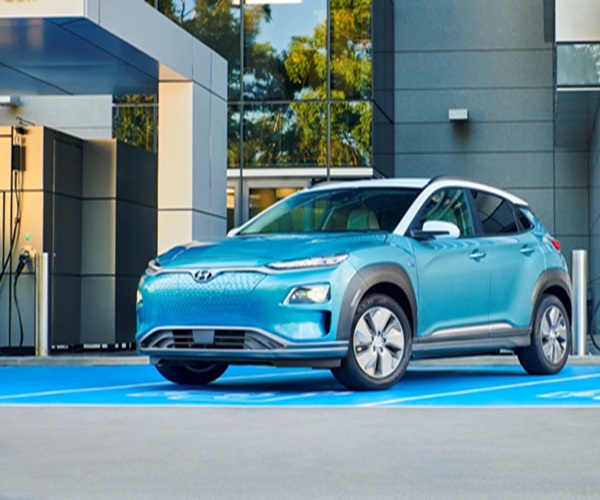
It’s the South Korean brand’s newest and most expensive model, and arguably its most advanced. The Kona Electric is powered by the company’s second-generation electric drivetrain with power outputs and driving range similar to a conventional model.
While it costs significantly more - priced from $59,990 (plus on-road costs) - it delivers 150kW/395Nm and can drive up to 449km on a fully battery, making it a tempting prospect for urban commuters or small families.
Its combination of range, performance and price means it stacks up well against its current EV competition (like the Tesla Model S and Model X as well as the Jaguar I-Pace). For those sick of waiting for a Tesla Model 3 - seen by many as the next step in affordable EVs - they may find it convenient to head into a Hyundai dealership today and drive out in a Kona Electric.
Arguably the Kona EV's biggest competition will come from within its own ranks with the Hyundai Ioniq Electric. It’s actually the cheapest EV on sale today, starting at just $44,490 (plus on-road costs), but its range is roughly half that of the Kona, at approximately 230km. While that is realistically enough for most drivers to live with, it may be a psychological barrier for some which will turn them towards the Kona.
Read our review of the Hyundai Kona Electric here: Hyundai Kona Electric
Jaguar I-Pace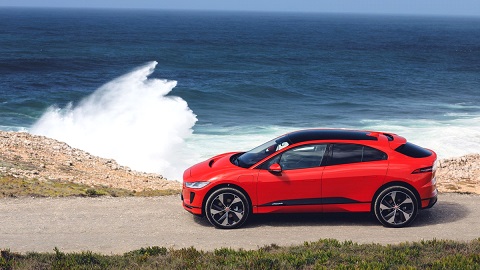
Tesla stole a march on the entire car industry by creating a market for luxury electric vehicles. But the rest of the premium brands are catching up, and Jaguar was the first to get a car into showrooms.
The I-Pace went on sale in Australia at the end of 2018 and gives people considering a Tesla a genuine alternative - even if the American and British brand’s aren’t traditional rivals.
Priced from $123,814 (plus on-road costs) for the entry-level S EV400 and stretching to $145,723, the leaping cat is competitively priced against the Model X.
While it straddles the line between SUV and passenger car with its low-slung and uniquely shaped body, the I-Pace is a practical five-seater with a real-world range of more than 400km. It also comes with the heritage and image of one of the motoring industry’s most evocative brands, which cannot be dismissed in the cut-throat world of prestige car sales.
The weight of the batteries has an impact on its handling but Jaguar has still been able to instil in the I-Pace with a similar level of performance and dynamic prowess we’ve come to expect from the brand that created the E-Type and XJ.
Click here to read our Jaguar I-Pace road test: Jaguar I-Pace
Nissan Leaf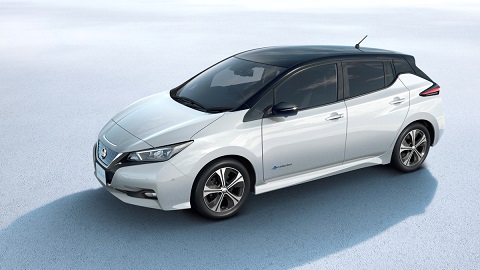
The Nissan could lay claim to being the most successful EV to date, with more than 400,000 examples of the battery-powered small hatch selling around the world since it first launched nearly a decade ago.
The second-generation is due to reach Australia in August, which is well after its promised on-sale date of late 2018. But the reason for the delay is its popularity in other markets meant Nissan Australia couldn’t get supply - which is a good problem to have for the Japanese car maker in the grand scheme of things.
The Leaf's popularity is simple - it’s affordable (especially in markets with government incentives for EVs), it’s practical (it will seat five and has a sizeable boot), it has a 270km range and is backed by Nissan’s reputation for dependable motoring.
The lack of government support for EVs means a starting price of $49,990 (plus on-road costs) is more than an equivalent-sized small car, but it does undercut the Kona Electric and Tesla Model 3. Plus, the Leaf has the ability to do something no other EV can - pump electricity back into the power grid.
That means, eventually, owners will be able to take advantage of fluctuations in the power supply and sell back to the grid when demand is high and recharge in the off-peak periods when electricity is at its cheapest.
Check out our review of the new Nissan Leaf here.
Tesla Model 3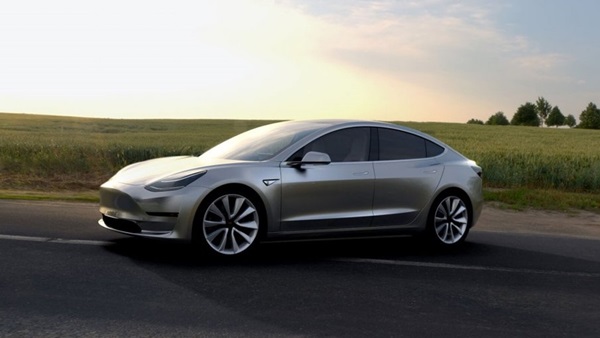
Few cars have enjoyed as much hype as the Model 3, Tesla’s smallest and most affordable EV. First revealed back in March 2016 it isn’t due to go on sale locally until later this year (with an exact launch date yet to be announced) which means plenty of would-be owners have waited a long time to get into the brand’s most affordable model.
If its success overseas is any indication it could be a popular choice for those looking to make the EV switch; in 2018 it was the world's best-selling EV with 138,000 sold.
Details are scarce at present with pricing yet to be revealed by Tesla Australia but it’s available in the US in two different specifications, with a standard model claiming a 354km range and the more expensive long range going 498km between trips to the powerpoint.
According to Tesla’s charismatic, Twitter-friendly chief, Elon Musk, pricing is expected to be inline with the US plus local charges. That points to an approximate $50,000 starting price for the entry-level model with single motor, which has just gone into production, while the higher grade twin-motor models could stretch to closer to $100k.
Given the brand’s recent fluctuations in pricing it’s hard to predict exactly how much it will cost when it does land. What’s more certain is the reputation Tesla has brought to EVs should help make the Model 3 a success down under.
Learn more about the Tesla Model 3.
Mercedes-Benz EQ C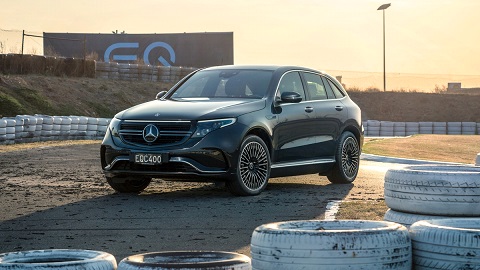
Formula One champ Lewis Hamilton liked the new electric SUV from the three-pointed star he plans to add one to his vast collection of supercars.
He may be a company man but it still speaks to the quality and technology loaded into the first of 10 new EVs from Mercedes coming in the next few years. It will go on sale locally in the October of this year, with a price tipped to be in the low six-figures.
While based on the existing GLC SUV, the EQ C gets a pair of electric motors to give it an impressive 300kW of power and 765Nm of torque, while the lithium-ion batteries are good for approximately 400km of range.
Like the Jaguar, it will bring the reputation of one of the automotive world’s biggest powerhouses, which should give buyers still uncertain about taking the plunge on their first EV the faith to take that next step.
Click here to read our first-hand experience of the EQ C.
Audi e-tron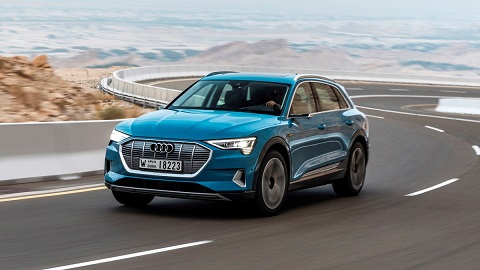
Not to be out-done by arch-rival Mercedes, Audi will follow the EQ C with a direct rival in the first quarter of 2020. The e-tron quattro, to give its full name, is a five-seat SUV that will lead the four-ring brand into a battery-powered future. Within the next five years, Audi showrooms will include the e-tron Sportback, Q4 e-tron and performance-focused e-tron GT four-door coupe.
Like the Benz it has a pair of electric motors good for 265kW (and 300kW on overboost) and 664Nm of torque. Its range hasn’t been finalised yet but it’s expected to be good for more than 400km; which is on par with the Mercedes and Jaguar.
Pricing isn’t confirmed but it’s tipped to start at approximately $140,000, which will put it in the ballpark for this time of premium electric SUV.
Styling is what will set the e-tron apart from its rivals, featuring the same edgy lines as the rest of the Audi range but with an even bolder, more futuristic look - both inside and out.
Read our first drive of the new Audi e-tron.
Porsche Taycan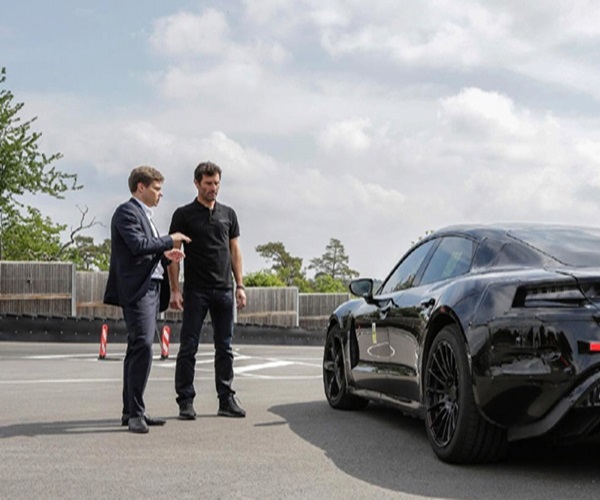
One of Tesla’s smartest moves was putting a spotlight on the performance benefits of electric cars. First came the Lotus-based Roadster and then ‘Ludicrous Mode’ in the Model S, which made it one of the quickest cars on the planet and made people stop thinking of EVs as glorified golf carts.
Porsche is likely to redefine that mindset when the Taycan is revealed in September before reaching Australia by the end of September 2020. The German brand has built its entire image around high-performance cars and the Taycan will be no exception.
It has not only set the target of being faster than the Model S, but also wants the performance to be consistent and repeatable. Beyond that, Australia’s own former F1 ace Mark Webber (pictured) was drafted in to help tune the dynamics of the chassis to make sure it handles like a Porsche, as well as lending his expertise to the delivery of the power.
It will also introduce a new 800-volt electrical system that will allow for what the brand calls ‘turbo charging’ - up to 80 per cent charge in just 15-minutes. Porsche Australia will roll out 350kW charging outlets at its dealers before expanding to destination charging to allow owners to explore in the Taycan.
Pricing isn’t confirmed yet but the brand has said it will sit above Cayenne but below Panamera in the range - meaning a starting price somewhere around $200k. Once the car is unveiled in September and the price is set the Australian order book will open and it’s expected to be a rush to secure a car, with supply restricted globally. Porsche initially anticipated building just 20,000 Taycans each year but greater initial interest could see double that figure - making it one of Porsche's best-selling models.
The Taycan won't be the only Porsche EV with plans to build a Cross Turismo wagon version and then transfer the tech to the Macan and Cayenne in their next-generation models.
Learn more about the Porsche Taycan here.
Volkswagen ID.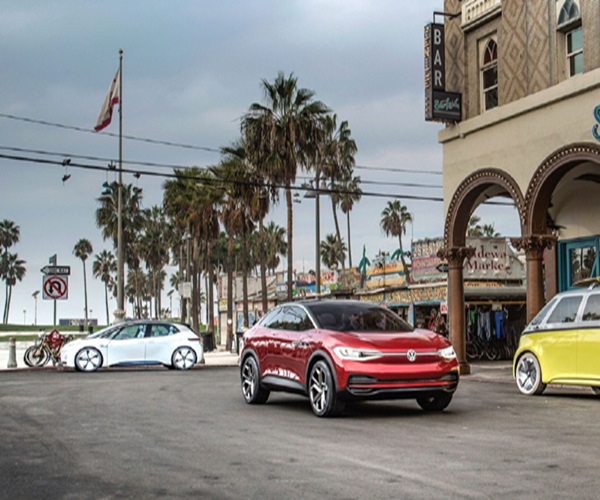
With its reputation damaged by the diesel emission scandal Volkswagen quickly shifted its focus to build an electrified future. As mentioned at the start, it wants to sell 22 million EVs within the next decade while offering 70 battery-powered models across the entire VW Group. Those are massive numbers, given that only 1.2 million EVs were sold around the world last year.
The Volkswagen brand itself will lead the charge, and while it falls outside of timeline of the next 18 months, the upcoming range of ID. models are too important to ignore. The ID. hatch will make its global debut later this year at the 2019 Frankfurt motor show, but given demand in other markets it won’t reach Australia until later 2021 or early 2022.
It will debut the VW Group’s ‘MEB’ electric vehicle platform that will underpin a variety of models. VW will follow the ID. with the ID. Crozz SUV, ID. Vizzion sedan and ID. Buzz; the re-born electric Kombi. While campervan fans will love the Buzz if it keeps the retro-styling, it will also double as a light commercial vehicle which could have a major impact on VW’s ability to hit its ambitious sales targets.
Technical details of the production ID. are being kept under wraps until closer to the launch but the company has indicated it will be able to offer different levels of batteries that will have an impact on price and range; less batteries equaling a more affordable starting price.
Learn more about Volkswagen electric vehicle plans.
Are you ready to go electric?Electric vehicles are on the way, but are they right for you?
Putting aside the costs, because not everyone can afford a $100k luxury SUV or even a $45k small car, there are several other questions you need to ask before making the switch.
The first one is; how much do you use your car? If you’re driving hundreds of kilometres each day or spend every weekend getting out of town into the country or down the coast, then an EV is probably not for you; at least not your only car. But, if like most people, you have a regular commute to and from work and generally stay local on weekends then there’s no reason for you to feel any range anxiety about this new generation of EVs.
Another major factor in preparing for an electric car is working out how you’re going to charge it. Obviously a garage is incredibly helpful for that, because if you don’t have off-street parking it may be tricky running an extension cord down the road. If you do have somewhere to park and charge your car you’ll need to invest in a high-voltage wallbox that are typically sold via the dealer and installed by an electrician, allowing you to charge the car faster than via a regular power socket.
The catch for EVs in Australia at present is the majority of our electricity supply comes from coal-fired power stations, which negates much of the environmental benefits of switching. However, there are green energy options or you could install solar panels to generate your own power for your car.
The Electric Vehicle Council has recently introduced an online calculator that allows you to see what savings you can make by switching to an EV. Check it out here: EV cost calculator
• Audi • battery electric vehicle • EV • Hyundai • Jaguar • Mercedes-Benz • Nissan • Porsche • tesla • Volkswagen Stephen Ottley:Stephen has been interested in cars as long as he can remember. Speed is in the blood as his great-grandfather was a motor racing pioneer in Australia, establishing several land speed and racing records. Based in Sydney, professionally he has been writing about everything on four-wheels since 2001…


A widespread network of highly visible electric car charging stations in Victoria is critical to prevent “range anxiety” - a fear of being stranded and unable to recharge - according to a consultation paper into how to make the state ready for zero emissions vehicles.
The Victorian government has launched a new map of existing and proposed electric charging stations across Victoria with the latest ultra-rapid charging station opening in Moe earlier this month.
"It's a totally new way of driving": Chris Stone has become a fan of electric cars after being given a company car.
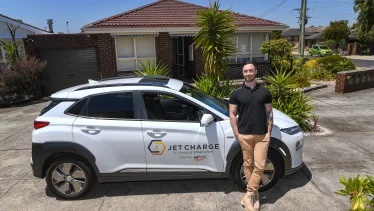
The map is intended to help Victorian drivers locate the 403 electric vehicle charging stations across the state, with another 31 expected to be constructed by the end of next year.
Victoria wants to encourage the use of electric cars as part of its strategy to tackle climate change with a long-term target of net zero greenhouse gas emissions by 2050.
However the number of electric vehicles in Victoria is currently small, with the Australian Bureau of Statistics 2018 motor vehicle census showing that just 0.056 per cent of passenger vehicles on our roads are powered by electric motors.
The state government consultation paper says range anxiety is a commonly cited barrier to the use of zero emission vehicles even though new models in the Australian market can drive more than 300 kilometres without recharging.
“A well-planned network of widespread and highly visible publicly available charging stations across Victoria is still critical to providing public confidence of being able to go where you want without the anxiety of being stranded between charging stations,” the paper says.
Victorian Environment Minister Lily D'Ambrosio said the Moe station - which delivers 400 kilometres of range in 15 minutes - and six other stations in Euroa, Barnawartha North (near Wodonga), Melbourne, Torquay, Ballarat and Horsham - were supported by $3 million in state government funding.
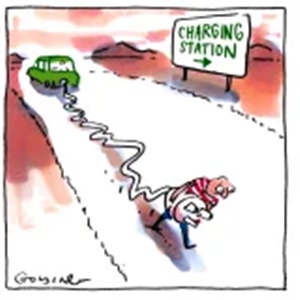
“We’re supporting new charging stations across the state so Victorians have confidence that they can take their zero emissions vehicles right across Australia,” Ms D’Ambrosio said.
In 2018 the government announced a deal that will see a commercial electric vehicle factory open in Morwell in the Latrobe Valley in 2021, manufacturing around 2,400 vehicles a year and creating up to 500 jobs.
The government is developing a Zero Emissions Vehicle Roadmap, to be released next year, which will set out the infrastructure and support needed to get more electric cars on the road.
It has released two papers for consultation.
One paper said just 0.1 per cent of new car sales in Australia in 2018 were fully electric vehicles. “Price is the main constraint on uptake,” it said.
Prices for electric cars were higher than those for conventional vehicles because the technology was new and Australia had a limited range of models, most of which were luxury brands such as BMW and Tesla.
Electric Vehicle Council chief executive Behyad Jafari said Australia lacked federal policies that supported the uptake of electric vehicles, such as fuel efficiency standards and tax incentives.
In Norway, for example, electric cars are exempted from most taxes and offered benefits such as free parking and charging points. Almost a third of new cars sold in Norway in 2018 were pure electric.
“A lot of the work is looking at how we get automotive makers to bring electric cars to Australia in the first place,” Mr Jafari said. “Cheaper models exist but they are not brought to Australia because we don’t have these policies.”
One of the consultation papers said Victoria would continue to lobby the Commonwealth to implement light vehicle co2 emission standards, review the luxury car tax and fringe benefits tax and improve fuel consumption labelling.
It also warned that our current electricity network was not designed to accommodate the large increase in demand that would come with electric vehicles.
“Government will need to work closely with distribution businesses (responsible for the management and upgrade of our electricity networks) to manage this new demand and potential impacts for peak demand,” it said.
It also said there was a need to inform drivers about the benefits of zero emission vehicle. “On average, a 100 km trip costs around $16.65 for a petrol vehicle. The same trip would cost $4.50 in a battery electric vehicle. And because they have fewer parts, they have lower maintenance costs.”
Chris Stone was given an electric company car to use shortly after he started working for JET Charge, an electric car charging company, just over a year ago.
He said he initially experienced range anxiety on longer trips until he realised there was little difference between planning for trips with electric cars and petrol cars.
“I just watch the gauge more - unless you are totally naive, you are never going to run out of power,” Mr Stone said.
He said even if there was not an ultra-rapid charging station nearby, electric cars could still be recharged anywhere with a power point, although it takes longer.
Mr Stone said he was now a fan of electric vehicles, which cost less to service and were cheaper to run. “The benefit to the environment is just a bonus,” he said.
Mr Stone showed his relatives his electric car on Christmas Day. “When they saw it has no gears, instant power, it was like the Jetson’s hovercraft had got here. It’s a totally new way of driving.”
Jewel Topsfield is Melbourne Editor of The Age.
DVD: "Who Killed the Electric Car? (2006)
Available in Australia


Mannie and Kendall Present: LESBIAN AND GAY SOLIDARITY ACTIVISMS
Mannie's blogs may be accessed by clicking on to the following links:
MannieBlog (from 1 August 2003 to 31 December 2005)
Activist Kicks Backs - Blognow archive re-housed - 2005-2009
RED JOS BLOGSPOT (from January 2009 onwards)

This page was created on 10 MARCH 2014 and updated 4 JULY 2021
PAGE 80